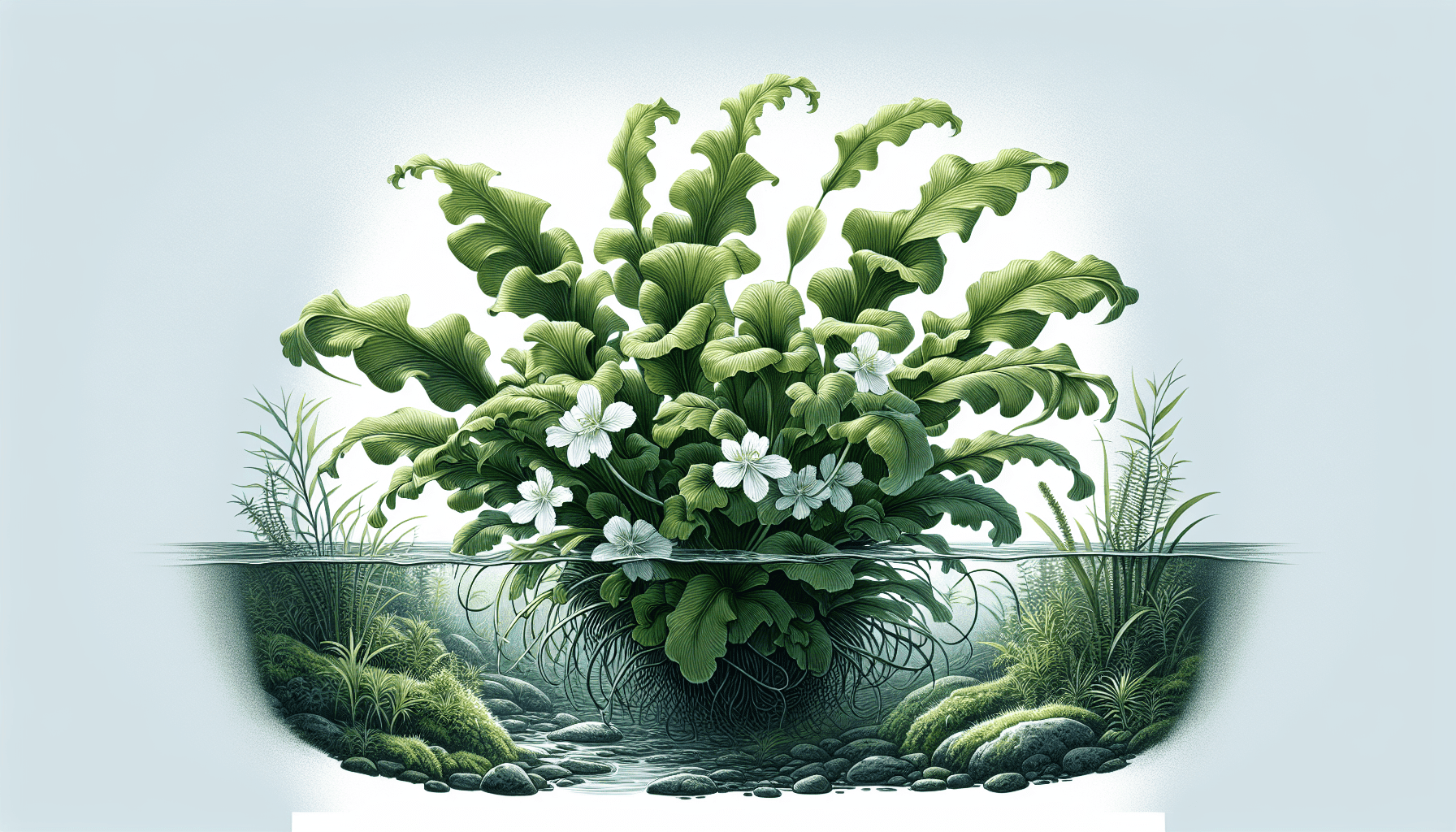As you embark on a journey through the niche yet intriguing world of aquatic plants, you will encounter the Aponogeton Crispus, a popular and important aquatic weed. This comprehensive article will broaden your understanding of it, exploring its characteristic features, the ecological role it plays in aquatic ecosystems, and the implications for its cultivation and management. The knowledge you gain herein will serve as an insightful resource, shedding light on the relatively unexplored and underappreciated realm of aquatic weed species.
Aponogeton Crispus Identification
Aponogeton crispus is a native aquatic plant species from South Asia distinguished by its uniquely crinkled leaves, high growing rates, and adaptability. An understanding of the plant’s physical characteristics will aid in its recognition and successful cultivation.
Physical Characteristics
Mature Aponogeton crispus can reach lengths of 12 to 35 inches in optimal growth conditions. Its long, slender stem attaches to the rhizomatous root system, rising vertically from the substrate surface with olive-green to brownish coloration.
Leaf Structure
The leaves of Aponogeton Crispus are the plant’s most notable feature, novelty crinkled and lanceolate. These undulating leaves, which span from 8 to 20 inches in length and approximately 1 inch in width, have a fine texture and a bright green hue. They’re alternately arranged from the base of the stems, creating a cascading appearance that contributes to the plant’s overall aesthetic appeal.
Seed Pods and Flowers
Throughout the flowering stage, Aponogeton crispus develops inflorescences or flower spikes that emerge above the water surface. Each spike features small, aromatic white flowers that subsequently form green, elongated seed pods.
Color and Texture Variations
A range of color variations exist within this plant species, ranging from soft green to darker brownish hues. The leaf texture is also variable, with newer leaves appearing smoother and older leaves developing the characteristic crinkled or undulated texture with age.
Habitat and Growth Conditions
Understanding the typical habitats and ideal growth conditions of Aponogeton Crispus is crucial for cultivating this plant in home aquariums or preserving its natural populations.
Water Conditions Needed
As a naturally aquatic species, Aponogeton crispus thrives in slightly acidic to slightly alkaline water (pH between 6.5 to 7.5). The plant also prefers soft to moderately hard water, high light conditions, and a nutrient-rich substrate for optimal growth and development.
Ideal Temperature Range
The ideal temperature ranges from 22 to 28 °C (72 to 82 °F). Aponogeton crispus can tolerate slightly cooler or warmer conditions, but drastic or prolonged temperature changes may hinder its growth and survival.
Natural Habitats of Aponogeton Crispus
Aponogeton crispus is native to South Asia, particularly Sri Lanka and India, where it populates freshwater habitats such as rivers, ponds, and streams. These environments provide the stable water conditions, ample sunlight, and nutrient-rich sediments that aid the plant’s survival.
Adaptations for Aquatic Life
In its natural aquatic habitats, Aponogeton crispus exhibits adaptations such as flexible stems and robust root systems that anchor it to the substrate, and large, buoyant leaves that aid its photosynthetic efficiency, even in deep or turbid water.

Lifecycle and Growth Cycle
The life cycle of the Aponogeton crispus involves periods of burgeoning growth, maturity and flowering, dormancy, and regeneration—common processes for various plants, especially aquatic species, which are subject to changing environmental conditions.
Growth from Seed
Aponogeton crispus initiates its lifecycle from seeds enclosed within the characteristic seed pods produced after flowering. Submerged in water, the seeds eventually germinate and begin root and leaf formation.
Maturity and Flowering Stage
Upon reaching maturity, which can occur within a few weeks under optimal conditions, Aponogeton crispus erupts in a burst of growth. The plant develops its distinctive crinkled leaves, long stems, and eventually, the inflorescences.
Dormancy Stage in Adverse Conditions
When exposed to adverse conditions such as extreme temperatures or nutrient scarcity, Aponogeton crispus may enter a natural dormancy stage for survival. During dormancy, most leaves shed off while the bulbs remain dormant in the substrate, conserving energy and resources.
Rejuvenation from Dormancy
Once favourable conditions return, the dormant bulbs sprout new leaves and roots, marking the rejuvenation stage of the Aponogeton crispus lifecycle. While rejuvenation can occur naturally, specific environmental cues, such as increased light or nutrient availability, can initiate this phase more rapidly.
Environmental Impact of Aponogeton Crispus
While Aponogeton crispus is a coveted decorative aquarium plant, its environmental impacts, particularly its roles within aquatic ecosystems and possible invasive potential, should not be overlooked.
Role in Aquatic Ecosystems
In its native habitats, Aponogeton crispus, like most aquatic plants, contributes to habitat structure, nutrient cycling, and food web support. The plant’s large leaves provide shelter for small aquatic creatures and serves as a food source for herbivores.
Effects on Water Quality
Aponogeton crispus can improve water quality by absorbing excess nutrients and releasing oxygen during photosynthesis. However, unchecked growth can lead to an imbalance, potentially affecting water quality and other aquatic organisms adversely.
Impact on Local Aquatic Fauna
The plant species creates habitats and foraging grounds for local aquatic fauna, but conversely, its rapid growth may outcompete other species for resources, influencing biodiversity negatively.
Invasive Potential Outside Natural Habitats
While Aponogeton crispus is not typically a problematic invasive species, caution is advised when introducing the plant outside its natural range—especially since its high growth rate and adaptability could allow it to outcompete native vegetation.

Cultivation and Care in Home Aquariums
Aquarists often seek Aponogeton crispus for its aesthetic appeal, rapid growth rate, and ease of care. This section guides you through the effective cultivation and care of this aquatic plant in home aquariums.
Planting Techniques
To plant Aponogeton crispus in an aquarium, place the bulb in a nutrient-rich substrate with the sprouting end facing upwards. The bulb should not be buried too deep—about half submerged in the substrate—aids in proper root development.
Water Treatment Requirements
The water within the home aquarium should replicate the natural conditions of Aponogeton Crispus. That entails maintaining a slightly acidic to neutral pH, soft to moderately hard water, and ensuring the presence of macro and micro nutrients necessary for plant growth. In cases where tap water is treated with chlorine or chloramines, dechlorinators should be used as these substances can harm or kill the plant.
Lighting and Temperature Control
High-intensity lighting provides the plant with the energy it needs for photosynthesis. A good rule of thumb is to provide around 2 to 4 watts per gallon of water. Moreover, the aquarium water temperature should ideally be maintained within a range of 22 to 28 °C.
Daily Care and Maintenance
Regular pruning of the Aponogeton Crispus encourages bushier growth and helps control plant size within the aquarium. Once the plant reaches dormancy, remove any shed leaves and allow for a period of rest before the plant rejuvenates.
Propagation Methods
Aponogeton crispus can be propagated through sexual reproduction via seed or asexual reproduction using its root system, much like other flowing plant species.
Sexual Reproduction
Upon the maturity and flowering stage, the plant produces fertile seeds encapsulated within the seed pods—each containing multiple seeds. Upon maturity, the seed pods release the seeds, which will float around before finally settling into the substrate to grow into a new plant.
Asexual Reproduction
Aponogeton crispus can reproduce asexually by forming new bulbs from the parent bulb. Once the new bulbs have grown to a sufficient size, they can be separated and planted independently.
Seeding and Transplantation Techniques
For propagation through seeds, the seeds can be directly sowed in the aquarium’s substrate. However, it could take several weeks for noticeable sprouts to appear. For bulb propagation, when the new bulb is large enough, it can be cautiously removed and replanted into the substrate.
Timing and Handling of Seed Pods
It’s critical to allow the seed pods to naturally reach full maturity before they are harvested to ensure that the seeds within are viable. The pod should be gently picked off from the flower stalk, ballooned end first, dried and later split open to release the seeds.
Ideal Companions for Aponogeton Crispus in Aquariums
When designing an aquarium, it’s crucial to consider the compatibility of the Aponogeton crispus with other inhabitants.
Compatible Aquatic Plants
Aponogeton crispus can be companioned with various aquatic plants that can tolerate similar conditions, providing these don’t overly compete for resources. A balanced combination of slow and fast-growing plants, such as Anubias, Java Fern, or crypto species, can help create a natural and visually appealing aquarium landscape.
Fish and Aquatic Creatures
Compatible fish species include those which naturally cohabit with Aponogeton in the wild or can adapt to similar tank conditions. Many smaller, peace-loving fish species, as well as shrimps and snails, can coexist with Aponogeton Crispus.
Tank Setup and Design Considerations
When setting up a tank, consider the plant’s maximum potential height and growth rate. As Aponogeton crispus is a back or mid-ground plant, it’s best placed near the back or sides of the aquarium, preventing it from overshadowing other tank inhabitants.
Balancing the Ecosystem
Establishing a balanced aquarium ecosystem involves managing the number and types of tank inhabitants, maintaining appropriate water conditions, and ensuring adequate nutrient availability—all while keeping the aquarium aesthetically pleasant.
Common Diseases and Pests
Being aware of potential diseases and pests can ensure the health and longevity of your Aponogeton Crispus.
Identifying Common Diseases
Aponogeton crispus isn’t susceptible to many diseases, but poor water conditions could lead to issues like root rot or algae invasion. Unhealthy plants may display signs like yellowing or wilting leaves, stunted growth, or excessively transparent leaves.
Preventing Pests Infestations
Pests like snails or algae can infest Aponogeton Crispus. You can prevent such infestations by regularly cleaning the aquarium, maintaining ideal water conditions, and considering biological control methods, like predator introduction.
Treating Affected Plants
Treatment methods depend on the specific issue at hand. For instance, root rot can be managed by improving water quality, whereas specific treatments may be required for certain algae or pests.
Preventive Measures and Care
Preventive care is crucial for maintaining healthy Aponogeton Crispus. Ensuring appropriate water conditions, providing sufficient nutrients, and regular inspection of the plants can effectively prevent most diseases and pests.
Practical Uses of Aponogeton Crispus
Beyond its aesthetic appeal, Aponogeton Crispus has various practical uses ranging from culinary to medicinal.
Decorative Uses in Aquariums and Ponds
As a visually pleasing plant species, Aponogeton crispus is commonly utilized in aquariums or ponds to enhance the landscape and provide a natural environment for aquatic inhabitants.
Culinary Uses
In certain areas, Aponogeton Crispus is harvested from the wild for its edible tubers and roots. These are often cooked or eaten raw, and are said to have a mildly sweet taste.
Medicinal Properties and Uses
While not widely documented, some traditional medicinal uses of Aponogeton Crispus have been reported. Its decoction supposedly has calming effects and has been historically used as a remedy for skin ailments or wounds.
Other Traditional and Local Uses
In some of its native areas, Aponogeton Crispus is used for religious or cultural ceremonies, owing to the plant’s unique appearance and fragrance.
Conservation and Sustainability Efforts
As we understand the importance of maintaining biodiversity, efforts to conserve and sustain the Aponogeton Crispus species are increasingly crucial.
Status in Wild Habitats
Aponogeton Crispus is not currently listed as a threatened species. However, alteration or destruction of its natural freshwater habitats due to human activities could potentially impact its wild populations.
Threats and Challenges
Major threats to Aponogeton Crispus include environmental pollution, habitat destruction, and overharvesting from the wild for commercial or local use.
Conservation Programs and Protected Areas
To safeguard this species, it’s essential to establish and enforce conservation programs, which could involve protecting existing habitats, controlling pollution, and regulating harvesting practices.
Sustainability in Commercial Uses
Sustainability should be a priority in all commercial uses of Aponogeton Crispus. This can be achieved by promoting responsible harvesting and cultivation methods, including propagation in controlled environments to reduce pressure on wild populations.